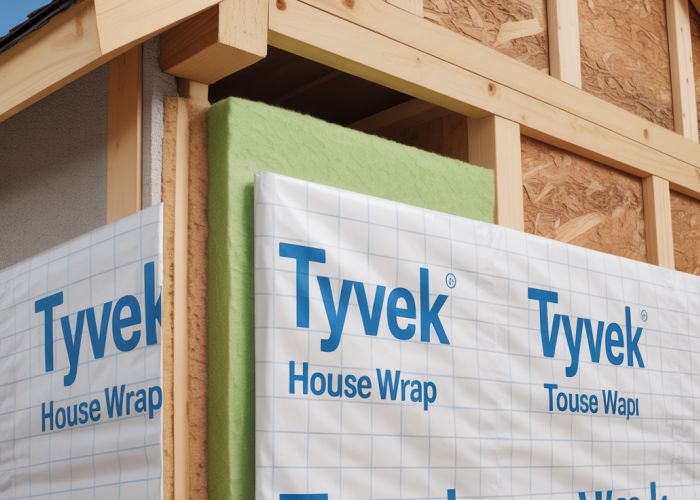Understanding tyvek perm rating is paramount for homeowners prioritizing energy efficiency and preventing moisture damage. Proper building envelope design, informed by tools like the ASTM E96 testing standard, necessitates careful consideration of vapor permeability. The DuPont company, a leading manufacturer of Tyvek, provides extensive resources on achieving optimal perm ratings. Ignoring this critical factor can lead to significant issues for homeowners and require the expertise of a qualified building inspector, potentially impacting the overall Home value.

Understanding Tyvek Perm Rating: A Guide for Homeowners
This article aims to provide homeowners with a clear understanding of the "Tyvek perm rating" and its significance in home construction and maintenance. We’ll break down what a perm rating is, how it applies to Tyvek house wrap, and why it’s crucial for preventing moisture-related issues.
What is a Perm Rating?
A perm rating, short for permeability rating, measures a material’s ability to allow water vapor to pass through it. It’s a crucial metric for assessing the breathability of building materials, particularly those used in walls and roofs. The higher the perm rating, the more easily water vapor can pass through the material. The unit of measure is perms (grains of water vapor passing through a square foot of material per hour with a difference in vapor pressure of one inch of mercury).
Understanding Vapor Transmission
Water vapor is always present in the air, both inside and outside your home. It’s generated from activities like showering, cooking, and even breathing. When warm, moist air comes into contact with a cold surface, condensation can occur. This condensation, if trapped within walls, can lead to mold growth, wood rot, and other structural problems.
- Vapor Drive: The force that moves water vapor from areas of high concentration to areas of low concentration. This drive is influenced by temperature and humidity differences.
- Importance of Breathability: Allowing water vapor to escape from walls and roofs prevents moisture buildup and potential damage.
Tyvek and Its Perm Rating
Tyvek is a synthetic material commonly used as a house wrap during construction. It acts as a barrier against liquid water intrusion while still allowing water vapor to escape from the wall assembly. Understanding the "Tyvek perm rating" is essential to appreciate its role in moisture management.
Specific Tyvek Perm Ratings
Tyvek comes in various formulations, each with a slightly different perm rating. It is important to check the manufacturer’s product data sheet for the specific Tyvek product being used. However, typical values include:
- Tyvek HomeWrap: Generally has a perm rating of around 56 perms.
- Tyvek CommercialWrap: Often has a similar, or slightly higher, perm rating than HomeWrap.
- Tyvek DrainWrap: Designed for enhanced drainage and typically has a high perm rating similar to HomeWrap.
These ratings are based on standard testing conditions, and the actual performance can vary depending on factors such as temperature, humidity, and installation methods.
Significance of Tyvek’s Perm Rating
Tyvek’s relatively high "Tyvek perm rating" allows it to effectively mitigate moisture buildup within walls. The value signifies that Tyvek is considered a breathable membrane. This breathability is crucial for:
- Preventing Mold and Mildew: By allowing moisture to escape, Tyvek helps prevent the growth of mold and mildew within wall cavities.
- Protecting Structural Integrity: Minimizing moisture buildup reduces the risk of wood rot and other structural damage.
- Improving Energy Efficiency: Dry insulation performs more effectively than wet insulation, leading to better energy efficiency.
Factors Affecting Perm Rating Effectiveness
While the "Tyvek perm rating" is a critical factor, other variables influence its effectiveness in managing moisture:
- Climate: In humid climates, managing moisture is even more critical.
- Construction Methods: Proper installation of Tyvek and other building materials is crucial for optimal performance. Overlaps and sealing are vital.
- Vapor Retarders: The strategic placement of vapor retarders within the wall assembly can help control moisture flow.
- Ventilation: Adequate ventilation in attics and crawl spaces is essential for removing moisture.
Comparing Tyvek to Other House Wraps
Many other house wrap products exist on the market. These products vary in material composition, perm rating, and performance characteristics.
Key Considerations
Here’s a table summarizing the key differences to keep in mind:
| Feature | Tyvek | Other House Wraps (Example: Polyethylene) |
|---|---|---|
| Material | Spunbonded Olefin | Various (Polyethylene, Woven Polypropylene) |
| Perm Rating | High (e.g., 56 perms for HomeWrap) | Can range from Very Low to High |
| Water Resistance | Excellent | Variable, depends on the product |
| UV Resistance | Good | Variable, depends on the product |
| Tear Resistance | Good | Variable, depends on the product |
| Cost | Generally Mid-Range | Can range from Low to High |
It’s important to research and compare the "Tyvek perm rating" with the ratings of other products to determine the best choice for your specific needs and climate.
Choosing the Right House Wrap
Selecting the right house wrap requires careful consideration of your climate, building design, and budget. Consult with a building professional or contractor to determine the most appropriate product for your project. Ask them about the specific requirements for your geographical location. They should be knowledgeable about local building codes and best practices for moisture management.
Alright, you’ve now got the lowdown on the **_tyvek perm rating_**. Hope this helps you make smart choices for your home. Good luck out there!